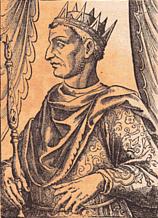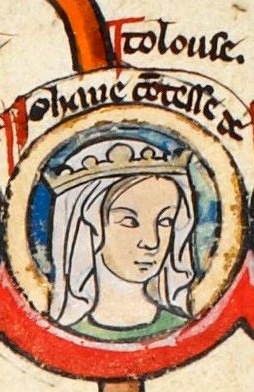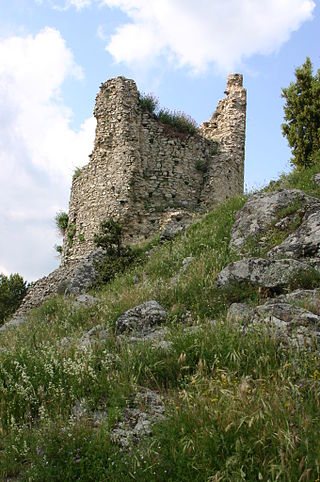Sources
- Alio, Jacqueline. Margaret, Queen of Sicily. Trinacria: New York, 2017.
- Norwich, John Julius. The Kingdom in the Sun 1130-1194. Longman: London, 1970.
Matthew Bonnellus (Italian : Matteo Bonello or Bonnel) was a rich knight of an ancient and influential Norman family who became the lord of Caccamo in Sicily. He is most famous as the leader of three consecutive revolts against the ammiratus ammiratorum Maio of Bari and King William I of Sicily.
When young he was attached to Maio, who destined him to be his son-in-law, and sent him on a diplomatic mission to Calabria. While there, Bonnellus became romantically involved with Clementia, Countess of Catanzaro, the heiress of Count Robert of Catanzaro. In return for her hand in marriage, he was induced to join the brewing conspiracy bent on Maio's assassination. According to Hugo Falcandus, on 10 November 1160, rumours began circulating in Palermo that "the King was coming that night, at Maio's instigation, to the Archbishop's palace, and that there, in that very street, he was to be slain." It was not, however the king, but the admiral, who was to be slain: with the complicity of the Archbishop Hugh. Matthew of Ajello warned Maio, but it was of no use. For immediately upon hearing his name mentioned, Bonnellus leapt from his crevice and stabbed the admiral while his attendants fled.
Bonnellus himself fled to Caccamo, but his popularity in the streets of the capital was such that the king was forced to grant him a pardon and he reentered Palermo as a hero. Under the urging of Queen Margaret, however, the king was prompted to demand a long-overlooked duty, a payment owed by Bonnellus for his inheritance, of 60,000 taris. Bonnellus paid, but his enmity with the king grew and his fellow conspirators convinced him to move to assassinate William. This he did by purchasing the support of Simon, the bastard son of Roger II, and Tancred, Count of Lecce, the bastard grandson of Roger, both Hauteville claimants to the throne. With the help of the prisoners in the dungeon, Simon and Tancred stormed the palace and captured the king. Many courtiers were killed and an anti-Moslem pogrom began, only halted by the narrowness of the streets in the Moslem quarter. Bonnellus himself was out of Palermo and it was announced that Roger, William's eldest son of nine years, already duke of Apulia, would be crowned in William's stead. The conspirators paused to await Bonnellus' return and the city reacted against them. The king was freed and the leaders fled to Caccamo.
Bonnellus himself led the rebels out of Caccamo in an assault on Palermo. Once again, however, the insurrectionists paused and allowed the momentum to pass from them and their enemies to regroup. Reinforcements arrived from Messina and the rebels were forced to accept very generous terms: exile for all and pardon for Bonnellus himself. Bonnellus charged the king's ministers with various evils to justify his actions and so proved to the king that he would never be pacific. William imprisoned him in a dungeon in al-Halka and Palermo revolted. This time all captured rebels were executed or mutilated and Bonnellus was blinded and hamstrung. He died soon thereafter in prison. His fiancée Clementia was exiled from Palermo to Calabria.

Roger II or Roger the Great was King of Sicily and Africa, son of Roger I of Sicily and successor to his brother Simon. He began his rule as Count of Sicily in 1105, became Duke of Apulia and Calabria in 1127, then King of Sicily in 1130 and King of Africa in 1148.

Robert "Guiscard" de Hauteville, sometimes Robert "the Guiscard", was a Norman adventurer remembered for his conquest of southern Italy and Sicily in the 11th century.

Tancred was King of Sicily from 1189 to 1194. He was born in Lecce, an illegitimate son of Roger III, Duke of Apulia by his mistress Emma, a daughter of Achard II, Count of Lecce. He inherited the title "Count of Lecce" from his grandfather and is consequently often referred to as Tancred of Lecce. Due to his short stature and unhandsome visage, he was mocked by his critics as "The Monkey King".

William I, called the Bad or the Wicked, was the second king of Sicily, ruling from his father's death in 1154 to his own in 1166. He was the fourth son of Roger II and Elvira of Castile.

Constance I was reigning Queen of Sicily from 1194–98, jointly with her spouse from 1194 to 1197, and with her infant son Frederick II, Holy Roman Emperor, in 1198. She is particularly notable for her actions against her own family, the Norman kings of Sicily; she played an important role in the end of the Hauteville presence in Sicily. She was also Holy Roman Empress and later Dowager by marriage to Henry VI, Holy Roman Emperor.

Margaret of Navarre was Queen of Sicily as the wife of William I (1154–1166) and the regent during the minority of her son, William II.

Joan of England was by marriage Queen of Sicily and Countess of Toulouse. She was the seventh child of King Henry II of England and Duchess Eleanor of Aquitaine. From her birth, she was destined to make a political and royal marriage. She married William II of Sicily and later Raymond VI, Count of Toulouse, two very important and powerful figures in the political landscape of Medieval Europe.

Maio of Bari was the third of the great admirals of Sicily and the most important man in the Norman kingdom of Sicily during the reign of William I (1154–66). Lord Norwich calls him "one of the most influential statesmen in Europe."

Margaritus of Brindisi, called "the new Neptune", was the last great ammiratus ammiratorum of the Kingdom of Sicily. Following in the footsteps of Christodulus, George of Antioch, and Maio of Bari, Margaritus commanded the kingdom's fleets during the reigns of William II (1166–1189) and Tancred (1189–1194). He probably began as a Greek pirate and gradually rose to the rank of privateer before becoming a permanent admiral of the navy. In 1185, he became the first count palatine of Cephalonia and Zakynthos. In 1192, he became the first Count of Malta. He also held the titles of Prince of Taranto and Duke of Durazzo.
Matthew of Ajello was a high-ranking member of the Norman court of the Kingdom of Sicily in the 12th century. His brother John was a bishop.
Simon, bastard son of Roger II of Sicily, was declared Prince of Taranto by his father in 1148, on the death of Roger III, Duke of Apulia, the eldest legitimate son of Roger II.
Gilbert was a Norman Count of Gravina from 1159 until 1167. His father Bertrand was the illegitimate son of Rotrou III, Count of Perche. He was a cousin of Margaret of Navarre, the queen of Sicily. He arrived in Sicily sometime around 1159 and, through Margaret's influence, was created Count of Gravina in Apulia immediately.
Tancred of Conversano, the youngest son of Geoffrey, Count of Conversano, became the count of Brindisi on his father's death in 1100.

Sylvester, count of Marsico, was a Norman nobleman of the Kingdom of Sicily.

The House of Hauteville was a Norman family originally of seigneurial rank from the Cotentin. The Hautevilles rose to prominence through their part in the Norman conquest of southern Italy. By 1130, one of their members, Roger II, was made the first King of Sicily. His male-line descendants ruled Sicily until 1194. Some Italian Hautevilles took part in the First Crusade and the founding of the independent Principality of Antioch (1098).

The Norman conquest of southern Italy lasted from 999 to 1194, involving many battles and independent conquerors.
Hugh Lupin, called the Younger, was a baron of the Kingdom of Sicily. He was the eldest son of Count Hugh I of Catanzaro and Countess Clementia, and twin brother of Count Jordan of Bovino.

Jordan Lupin was the first count of Bovino in the Norman kingdom of Sicily. He played a major role in the final years of Norman rule and first years of the Staufer dynasty. Twice he was involved in opposing crusader armies passing through Sicily. In the second instance, he led a revolt, apparently in the hope of seizing the throne. He was successful in attracting significant support, and was even crowned anti-king, but was ultimately captured and executed.
Hugh Lupin, called the Elder or Hugh I, was a nobleman of the Kingdom of Sicily. He was the count of Catanzaro from 1167 until his death.

Clementia was the countess of Catanzaro in the Kingdom of Sicily. She played a major role in the baronial rebellion of 1160–62.